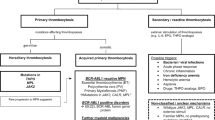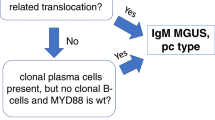Abstract
Hemophagocytic lymphohistiocytosis (HLH) is a life threatening hyperinflammatory syndrome characterized by excessive activation of macrophages and T cells resulting from defective cytotoxicity. Severe hyperinflammation caused by uncontrolled proliferation of activated lymphocytes and histiocytes (macrophages) secreting high amounts of inflammatory cytokines threatens the life of the patient and may lead to death unless arrested by appropriate treatment. HLH can be caused either by certain underlying genetic diseases (familial HLH), or may also occur due to particular triggers in patients with no known inherited disorder (acquired HLH). Due to life threatening nature of the disease, early diagnosis and initiation of immunosuppressive therapy is extremely important. HLH diagnosis is based on constellation of clinical manifestations and laboratory parameters which often overlap with those of severe infection or sepsis. Identification of patients with familial HLH and their underlying genetic defects requires specialized laboratory tests and is important for predicting relapses and planning early therapeutic hematopoietic stem cell transplantation (HSCT). A high suspicion and thorough clinical, immunological and genetic work-up is required for diagnosis of HLH. Prompt initiation of adequate treatment is essential for the survival. Substantial progress has been made in exploring the complex cause and pathophysiology of HLH and also in management of HLH patients.


Similar content being viewed by others
References
Janka GE. Familial and acquired hemophagocytic lymphohistiocytosis. Annu Rev Med. 2012;63:233–46.
Henter JI, Elinder G, Soder O, Ost A. Incidence in Sweden and clinical features of familial hemophagocytic lymphohistiocytosis. Acta Paediatr Scand. 1991;80:428–35.
Osugi Y, Hara J, Tagawa S, et al. Cytokine production regulating Th1 and Th2 cytokines in hemophagocytic lymphohistiocytosis. Blood. 1997;89:4100–3.
Scott RB, Robb-Smith AHT. Histiocytic medullary reticulosis. Lancet. 1939;234:194–8.
Farquhar JW, Claireaux AE. Familial haemophagocytic reticulosis. Arch Dis Child. 1952;27:519–25.
Gholam C, Grigoriadou S, Gilmour KC, Gaspar HB. Familial haemophagocytic lymphohistiocytosis: advances in the genetic basis, diagnosis and management. Clin Exp Immunol. 2011;163:271–83.
Filipovich AH. Hemophagocytic lymphohistiocytosis (HLH) and related disorders. Hematol Am Soc Hematol Educ Program. 2009;127-31.
Waleed A, Bousfiha A, Casanova JL, et al. Primary immunodeficiency diseases: an update on the classification from the international union of immunological societies expert committee for primary immunodeficiency. Front Immunol. 2014;22:162.
Dufourcq-Lagelouse R, Jabado N, Le Deist F, et al. Linkage of familial hemophagocytic lymphohistiocytosis to 10q21–22 and evidence for heterogeneity. Am J Hum Genet. 1999;64:172–9.
Ohadi M, Lalloz MR, Sham P, et al. Localization of a gene for familial hemophagocytic lymphohistiocytosis at chromosome 9q21.3–22 by homozygosity mapping. Am J Hum Genet. 1999;64:165–71.
Feldmann J, Callebaut I, Raposo G, et al. Munc13–4 is essential for cytolytic granules fusion and is mutated in a form of familial hemophagocytic lymphohistiocytosis (FHL3). Cell. 2003;115:461–73.
Zur Stadt U, Schmidt S, Kasper B, et al. Linkage of familial hemophagocytic lymphohistiocytosis (FHL) type-4 to chromosome 6q24 and identification of mutations in syntaxin 11. Hum Mol Genet. 2005;14:827–34.
Cote M, Menager MM, Burgess A, et al. Munc18–2 deficiency causes familial hemophagocytic lymphohistiocytosis type 5 and impairs cytotoxic granule exocytosis in patient NK cells. J Clin Invest. 2009;119:3765–73.
Zur Stadt U, Rohr J, Seifert W, et al. Hennies. Familial hemophagocytic lymphohistiocytosis type 5 (FHL-5) is caused by mutations in Munc18–2 and impaired binding to syntaxin 11. Am J Hum Genet. 2009;85:482–92.
Mhatre S, Madkaikar M, Desai M, Ghosh K. Spectrum of perforin gene mutations in familial hemophagocytic lymphohistiocytosis (FHL) patients in India. Blood Cells Mol Dis. 2015;54:250–7.
Barbosa MD, Barrat FJ, Tchernev VT, et al. Identification of mutations in two major mRNA isoforms of the chediak-higashi syndrome gene in human and mouse. Hum Mol Genet. 1997;6:1091–8.
Menasche G, Feldmann J, Fischer A, de Saint Basile G. Primary hemophagocytic syndromes point to a direct link between lymphocyte cytotoxicity and homeostasis. Immunol Rev. 2005;203:165–79.
Griscelli C, Durandy A, Guy-Grand D, Daguillard F, Herzog C, Prunieras M. A syndrome associating partial albinism and immunodeficiency. Am J Med. 1978;65:691–702.
Nagle DL, Karim MA, Woolf EA, et al. Identification and mutation analysis of the complete gene for chediak-higashi syndrome. Nat Genet. 1996;14:307–11.
Enders A, Zieger B, Schwarz K, et al. Lethal hemophagocytic lymphohistiocytosis in hermansky-pudlak syndrome type II. Blood. 2006;108:81–7.
Dell'Angelica EC, Shotelersuk V, Aguilar RC, Gahl WA, Bonifacino JS. Altered trafficking of lysosomal proteins in hermansky-pudlak syndrome due to mutations in the beta 3 a subunit of the AP-3 adaptor. Mol Cell. 1999;3:11–21.
Shotelersuk V, Dell'Angelica EC, Hartnell L, Bonifacino JS, Gahl WA. A new variant of hermansky-pudlak syndrome due to mutations in a gene responsible for vesicle formation. Am J Med. 2000;108:423–7.
Huizing M, Scher CD, Strovel E, et al. Nonsense mutations in ADTB3A cause complete deficiency of the beta3A subunit of adaptor complex-3 and severe hermansky-pudlak syndrome type 2. Pediatr Res. 2002;51:150–8.
Purtilo DT, Cassel C, Yang JP. Letter: fatal infectious mononucleosis in familial lymphohistiocytosis. N Engl J Med. 1974;291:736.
Rigaud S, Fondaneche MC, Lambert N, et al. XIAP deficiency in humans causes an X-linked lymphoproliferative syndrome. Nature. 2006;444:110–4.
Coffey AJ, Brooksbank RA, Brandau O, et al. Host response to EBV infection in X-linked lymphoproliferative disease results from mutations in an SH2- domain encoding gene. Nat Genet. 1998;20:129–35.
Schmid JP, Canioni D, Moshous D, et al. Clinical similarities and differences of patients with X-linked lymphoproliferative syndrome type 1 (XLP-1/SAP deficiency) versus type 2 (XLP-2/XIAP deficiency). Blood. 2011;117:1522–9.
Marsh RA, Villanueva J, Kim MO, et al. Filipovich. Patients with X-linked lymphoproliferative disease due to BIRC4 mutation have normal invariant natural killer T-cell populations. Clin Immunol. 2009;132:116–23.
Nichols KE, Ma CS, Cannons JL, Schwartzberg PL, Tangye SG. Molecular and cellular pathogenesis of X-linked lymphoproliferative disease. Immunol Rev. 2005;203:180–99.
Huck K, Feyen O, Niehues T, et al. Girls homozygous for an IL-2-inducible T cell kinase mutation that leads to protein deficiency develop fatal EBV-associated lymphoproliferation. J Clin Invest. 2009;119:1350–8.
van Montfrans JM, Hoepelman AI, Otto S, et al. CD27 deficiency is associated with combined immunodeficiency and persistent symptomatic EBV viremia. J Allergy Clin Immunol. 2012;129:787–93.
Janka G, Imashuku S, Elinder G, Schneider M, Henter JI. Infection- and malignancy-associated hemophagocytic syndromes. Secondary hemophagocytic lymphohistiocytosis. Hematol Oncol Clin North Am. 1998;12:435–44.
Tiab M, Mechinaud F, Harousseau J-L. Haemophagocytic syndrome associated with infections. Clin Haematol. 2000;13:163–78.
Rajagopala S, Dutta U, Chandra KS, Bhatia P, Varma N, Kochhar R. Visceral leishmaniasis associated hemophagocytic lymphohistiocytosis—case report and systematic review. J Infect. 2008;56:381–8.
Henter JI, Ehrnst A, Andersson J, Elinder G. Familial hemophagocytic lymphohistiocytosis and viral infections. Acta Paediatr. 1993;82:369–72.
Jordan MB, Allen CE, Weitzman S, Filipovich AH, McClain KL. How I treat hemophagocytic lymphohistiocytosis. Blood. 2011;118:4041–52.
Machaczka M, Vaktnas J, Klimkowska M, Hagglund H. Malignancy associated hemophagocytic lymphohistiocytosis in adults: a retrospective population-based analysis from a single center. Leuk Lymphoma. 2011;52:613–9.
Ramanan AV, Baildam EM. Macrophage activation syndrome is hemophagocytic lymphohistiocytosis–need for the right terminology. J Rheumatol. 2002;29:1105.
Ishii E, Ohga S, Tanimura M, et al. Clinical and epidemiologic studies of familial hemophagocytic lymphohistiocytosis in Japan. Japan LCH study group. Med Pediatr Oncol. 1998;30:276–83.
Gurgey A, Gogus S, Ozyurek E, et al. Primary hemophagocytic lymphohistiocytosis in Turkish children. Pediatr Hematol Oncol. 2003;20:367–71.
Arico M, Janka G, Fischer A, et al. Hemophagocytic lymphohistiocytosis. Report of 122 children from the international registry. FHL Leukemia. 1996;10:197–203.
Stinchcombe JC, Griffiths GM. Secretory mechanisms in cell-mediated cytotoxicity. Annu Rev Cell Dev Biol. 2007;23:495–517.
Gupta S, Weitzman S. Primary and secondary hemophagocytic lymphohistiocytosis: clinical features, pathogenesis and therapy. Expert Rev Clin Immunol. 2010;6:137–54.
Allen M, De Fusco C, Legrand F, et al. Familial hemophagocytic lymphohistiocytosis: how late can the onset be? Haematologica. 2001;86:499–503.
Bhattacharyya M, Ghosh MK. Hemophagocytic lymphohistiocytosis-recent concept. J Assoc Physicians India. 2008;56:453–8.
Pinto-Patarroyo GP, Rytting ME, Vierling JM, Suarez-Almazor ME. Haemophagocytic lymphohistiocytosis presenting as liver failure following Epstein-Barr and prior hepatitis a infections. BMJ Case Rep. 2013. doi:10.1136/bcr-2013-008979.
Chandrakasan S, Filipovich AH. Hemophagocytic lymphohistiocytosis: advances in pathophysiology, diagnosis, and treatment. J Pediatr. 2013;163:1253–9.
Lin T, Ferlic-Stark L, Allen C, Kozinetz C, McClain K. Rate of decline of ferritin in patients with hemophagocytic lymphohistiocytosis as a prognostic variable for mortality. Pediatr Blood Cancer. 2011;56:154–5.
Henter JI, Horne A, Arico M, et al. HLH-2004: diagnostic and therapeutic guidelines for hemophagocytic lymphohistiocytosis. Pediatr Blood Cancer. 2007;48:124–31.
Schram AM, Campigotto F, Mullally A, et al. Marked hyperferritinemia does not predict for HLH in the adult population. Blood. 2015;125:1548–52.
Shiota Y, Sato T, Ono T. Serum levels of soluble CD25 (soluble interleukin 2 receptor) in asthmatic patients. Arerugi. 1993;42:914–9.
Tsuji T, Hirano T, Yamasaki H, Tsuji M, Tsuda H. A high sIL-2R/ferritin ratio is a useful marker for the diagnosis of lymphoma-associated hemophagocytic syndrome. Ann Hematol. 2014;93:821–6.
Chen WF, Xu J, Qiu HX, et al. Detection of serum neopterin in patients with hemophagocytic lymphohistiocytosis and its significance. Zhongguo Shi Yan Xue Ye Xue Za Zhi. 2013;21:465–8.
Xu XJ, Tang YM, Song H, et al. Diagnostic accuracy of a specific cytokine pattern in hemophagocytic lymphohistiocytosis in children. J Pediatr. 2012;160:984–90.
Molleran Lee S, Villanueva J, Sumegi J, et al. Characterisation of diverse PRF1 mutations leading to decreased natural killer cell activity in north American families with haemophagocytic lymphohistiocytosis. J Med Genet. 2004;41:137–44.
Kogawa K, Lee SM, Villanueva J, Marmer D, Sumegi J, Filipovich AH. Perforin expression in cytotoxic lymphocytes from patients with hemophagocytic lymphohistiocytosis and their family members. Blood. 2002;99:61–6.
Bryceson YT, Pende D, Maul-Pavicic A, et al. A prospective evaluation of degranulation assays in the rapid diagnosis of familial hemophagocytic syndromes. Blood. 2012;119:2754–63.
Madkaikar M, Mishra A, Desai M, Gupta M, Mhatre S, Ghosh K. Comprehensive report of primary immunodeficiency disorders from a tertiary care center in India. J Clin Immunol. 2013;33:507–12.
Trottestam H, Horne A, Aricò M. et al; Histiocyte Society. Chemoimmunotherapy for hemophagocytic lymphohistiocytosis: long-term results of the HLH-94 treatment protocol. Blood. 2011;118:4577–84.
Mahlaoui N, Ouachée-Chardin M, de Saint BG, et al. Immunotherapy of familial hemophagocytic lymphohistiocytosis with antithymocyte globulins: a single-center retrospective report of 38 patients. Pediatrics. 2007;120:e622–8.
Marsh RA, Allen CE, McClain KL, et al. Salvage therapy of refractory hemophagocytic lymphohistiocytosis with alemtuzumab. Pediatr Blood Cancer. 2013;60:101–9.
Milone MC, Tsai DE, Hodinka RL, et al. Nichols. Treatment of primary Epstein-Barr virus infection in patients with X-linked lymphoproliferative disease using B-cell-directed therapy. Blood. 2005;105:994–6.
Sieni E, Cetica V, Piccin A, et al. Familial hemophagocytic lymphohistiocytosis may present during adulthood: clinical and genetic features of a small series. PLoS ONE. 2012;7:e44649.
Contributions
MM and SS: Conception, literature review and writing of the manuscript. MM and MD: Critically revising and final approval of the manuscript. MM will act as guarantor for the paper.
Author information
Authors and Affiliations
Corresponding author
Ethics declarations
Conflict of Interest
None.
Source of Funding
Indian Council of Medical Research (ICMR) and Department of Biotechnology (DBT).
Rights and permissions
About this article
Cite this article
Madkaikar, M., Shabrish, S. & Desai, M. Current Updates on Classification, Diagnosis and Treatment of Hemophagocytic Lymphohistiocytosis (HLH). Indian J Pediatr 83, 434–443 (2016). https://doi.org/10.1007/s12098-016-2037-y
Received:
Accepted:
Published:
Issue Date:
DOI: https://doi.org/10.1007/s12098-016-2037-y




